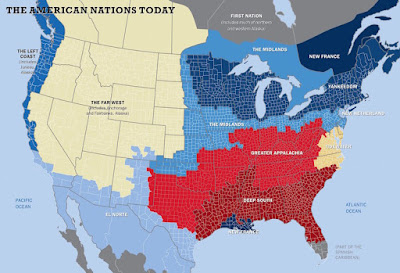American Nations by Colin Woodard **** (of 5)
Colin Woodard's cultural, historical, and geographic description of North America changed the way I see our country, its politics, and my neighbors. Woodard's argument is that the history of settlement in the New Word and the cultural traditions brought by those settlers prevail to this day and are more important than state boundaries or our country's rural-urban divide in describing how our political system is polarized into eleven distinct geographic units.
Here is one example that persuaded me beyond any doubt: the evolution of New York City, a nation virtually unto itself. New York was settled first by the Dutch in the 1500s (after Native Americans were dispatched, of course.) At that time Holland was the world's most liberal and open minded country in Europe. It was the one place where Jews were still free to practice -- Jews had been killed and banished from France, England, Germany, Spain, and Portugal. Puritans that had departed England because Britain had become insufficiently strict in its observance were also welcomed in Holland. What mattered to the Dutch was complete tolerance of different people and a willingness to work hard and become self-made in the world of business. After all, Holland was at that time the global center of trade with outposts in Africa, South America, the Middle East and Asia. While the number of Dutch living in New York City today is insignificantly tiny, is there any question that New York maintains that cultural identity as one of the most religious and ethnically tolerant places in the United States or that if you had to pick an American city as the epicenter of global trade, New York would still be that place?
I would encourage you to learn about the continent's other ten nations and their distinct and disputative histories if you want to understand the rise of Trumpism (Trump is a self-made businessman from New York, which tolerated him until he started denigrating minorities) and the nations that will never abide him (The Left Coast, for example.)
The book is ponderous in places so there is no need to read every word. Or, if you are in a hurry, check out this recent summary by Colin Woodard in the New York Times. The Maps That Show That City vs. Country is Not Our Political Fault Line (July 30, 2018).


Comments
Post a Comment